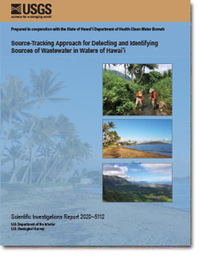Source-Tracking Approach for Detecting and Identifying Sources of Wastewater in Waters of Hawaiʻi
Links
- Document: Report (7 MB pdf)
- Download citation as: RIS | Dublin Core
Abstract
Elevated concentrations of nutrients and the fecal-indicator bacteria enterococci are occasionally detected in Hawai‘i’s surface waters by the State of Hawai‘i Department of Health Clean Water Branch. Management efforts to improve the water quality of surface waters are complicated by the fact that nutrients and enterococci can originate from several sources, including wastewater, animal waste, and soils. Wastewater often is the suspected source of nutrients and bacteria, but the source may not always be unequivocally identifiable from the Clean Water Branch’s routine monitoring efforts. This report—prepared in cooperation with the State of Hawai‘i Department of Health Clean Water Branch—describes a source-tracking approach for Hawai‘i that is meant to help investigators determine whether wastewater is present in the environment and where wastewater might be originating, if it is present. Wastewater sources include domestic wastewater entering the environment through on-site disposal systems and municipal wastewater entering the environment through leaky sewer systems or injection-well disposal systems. The source-tracking approach relies on the use of field-measured water properties and multiple chemical tracers of wastewater, including optical brighteners, nutrients, hydrogen and oxygen isotopes in water, nitrogen and oxygen isotopes in nitrate, organic waste compounds, and human-use pharmaceutical compounds. The source-tracking approach proposes the following sequence of steps for investigators to execute: (1) gather background information on the study area, (2) conduct trolling-instrument surveys of physical properties of surface water and identify groundwater-discharge locations, (3) collect water samples at reconnaissance sites and analyze the samples for detergent optical brighteners and specific conductance, (4) collect water samples at targeted sites and have appropriate laboratories analyze the samples for chemical tracers of wastewater, and (5) evaluate analytical results for chemical tracers of wastewater and conclude whether wastewater is present in sampled waters. The conclusions can guide management and stakeholder efforts to protect and improve the quality of Hawai‘i’s water resources.
Suggested Citation
Johnson, A.G., 2020, Source-tracking approach for detecting and identifying sources of wastewater in waters of Hawaiʻi: U.S. Geological Survey Scientific Investigations Report 2020–5112, 53 p., https://doi.org/10.3133/sir20205112.
ISSN: 2328-0328 (online)
Study Area
Table of Contents
- Acknowledgments
- Abstract
- Introduction
- Source-Tracking Approach
- Tiered Data-Collection Strategy
- Evaluating Laboratory Results of Chemical Tracers of Wastewater
- Developing Conclusions
- Suggestions for Future Studies
- Summary
- References Cited
| Publication type | Report |
|---|---|
| Publication Subtype | USGS Numbered Series |
| Title | Source-tracking approach for detecting and identifying sources of wastewater in waters of Hawaiʻi |
| Series title | Scientific Investigations Report |
| Series number | 2020-5112 |
| DOI | 10.3133/sir20205112 |
| Publication Date | December 04, 2020 |
| Year Published | 2020 |
| Language | English |
| Publisher | U.S. Geological Survey |
| Publisher location | Reston, VA |
| Contributing office(s) | Pacific Islands Water Science Center |
| Description | viii, 53 p. |
| Country | United States |
| State | Hawaii |
| Online Only (Y/N) | Y |


